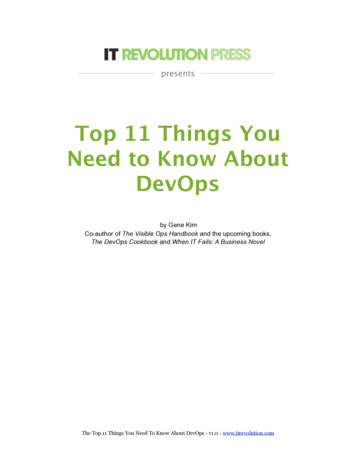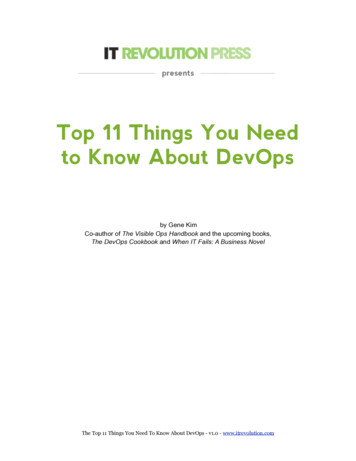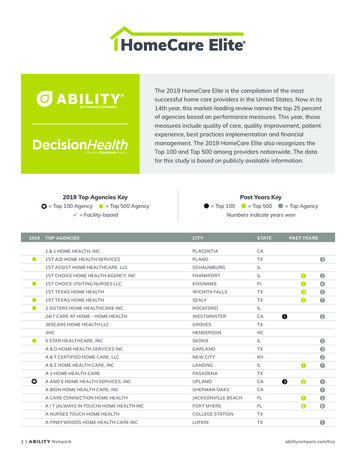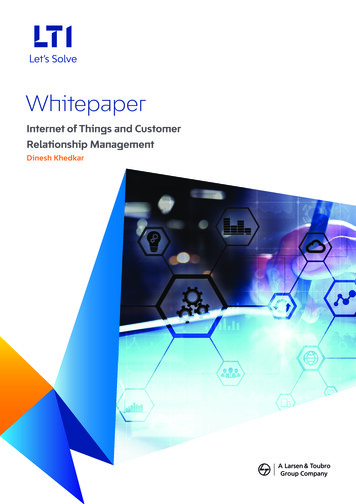
Transcription
presentsTop 11 Things YouNeed to Know AboutDevOpsby Gene KimCo-author of The Visible Ops Handbook and the upcoming books,The DevOps Cookbook and When IT Fails: A Business NovelThe Top 11 Things You Need To Know About DevOps - v1.0 - www.itrevolution.com
About the AuthorGene Kim is a multiple award winning CTO, researcher andauthor. He was founder and CTO of Tripwire for 13 years. Hehas written two books, including The Visible Ops Handbook, andis now writing When IT Fails: A Business Novel and The DevOpsCookbook. Gene is a huge fan of IT operations, and how it canenable developers to maximize throughput of features from “codecomplete” to “in production,” without causing chaos anddisruption to the IT environment. He has worked with some ofthe top Internet companies on improving deployment flow andincreasing the rigor around IT operational processes. In 2007,ComputerWorld added Gene to the “40 Innovative IT PeopleUnder The Age Of 40” list, and was given the Outstanding Alumnus Award by the Department ofComputer Sciences at Purdue University for achievement and leadership in the profession.The Top 11 Things You Need To Know About DevOps - v1.0 - www.itrevolution.com
Table of Contents1. What is DevOps and where did it come from?2. How does DevOps differ from Agile?3. How does DevOps differ from ITIL or ITSM?4. How does DevOps fit with VisualOps5. What are the unpinning principles of DevOps?6. What are the areas of DevOps patterns?7. What is the value of DevOps?8. How does Infosec and QA integrate into a DevOps work stream?9. My DevOps Favorite Pattern #110. My DevOps Favorite Pattern #211. My DevOps Favorite Pattern #3The Top 11 Things You Need To Know About DevOps - v1.0 - www.itrevolution.com
1. What is DevOps and where did it come from?The term “DevOps” typically refers to the emerging professional movement that advocates acollaborative working relationship between Development and IT Operations, resulting in the fastflow of planned work (i.e., high deploy rates), while simultaneously increasing the reliability,stability, resilience and security of the production environment.Why Development and IT Operations? Because that is typically the value stream that isbetween the business (where requirements are defined) and the customer (where value isdelivered).The origins of the DevOps movement are commonly placed around 2009, as the convergenceof numerous adjacent and mutually reinforcing movements: The Velocity Conference movement, especially the seminal “10 Deploys A Day” presentationgiven by John Allspaw and Paul Hammond The “infrastructure as code” movement (Mark Burgess and Luke Kanies), the “Agileinfrastructure” movement (Andrew Shafer) and the Agile system administration movement(Patrick DeBois) The Lean Startup movement by Eric Ries The continuous integration and release movement by Jez Humble The widespread availability of cloud and PaaS (platform as a service) technologies (e.g.,Amazon Web Services).One of the DevOps Cookbook co-authors, John Willis, wrote a fantastic piece on the“Convergence of DevOps” here:The Top 11 Things You Need To Know About DevOps - v1.0 - www.itrevolution.com
2. How does DevOps differ from Agile?One tenet of the Agile development process is to deliver working software in smaller and morefrequent increments, as opposed to the the “big bang” approach of the waterfall method. This ismost evident in the Agile goal of having potentially shippable features at the end of each sprint(typically every two weeks).High deployment rates will often pile up in front of IT Operations for deployment. Clyde Logue,founder of StreamStep, is attributed as saying “Agile was instrumental in Development regainingthe trust in the business, but it unintentionally left IT Operations behind. DevOps is a way for thebusiness to regain trust in the entire IT organization as a whole.”DevOps is especially complementary to the Agile software development process, as it extendsand completes the continuous integration and release process by ensuring the code isproduction ready and providing value to the customer.DevOps enables a far more continuous flow of work into IT Operations. When code is notpromoted into production as it is developed (e.g., Development delivers code every two weeks,but is deployed only every two months), deployments will pile up in front of IT Operations,customers don’t get value, and the deployments often result in chaos and disruption.DevOps has an inherent cultural change component, as it modifies the the flow of work andlocal measurements of Development and IT Operations. John Willis and Damon Edwards (bothDevOps Cookbook co-authors) wrote extensively about this here.The Top 11 Things You Need To Know About DevOps - v1.0 - www.itrevolution.com
3. How does DevOps differ from ITIL or ITSM?Although many people view DevOps as backlash to ITIL (IT Infrastructure Library) or ITSM (ITService Management), I take a different view. ITIL and ITSM still are best codifications of thebusiness processes that underpin IT Operations, and actually describe many of the capabilitiesneeded into order for IT Operations to support a DevOps-style work stream.Agile and continuous integration and release are the outputs of Development, which are theinputs into IT Operations. In order to accommodate the faster release cadence associated withDevOps, many areas of the ITIL processes require automation, specifically around the change,configuration and release processes.The goal of DevOps is not just to increase the rate of change, but to successfully deployfeatures into production without causing chaos and disrupting other services, while quicklydetecting and correcting incidents when they occur. This brings in the ITIL disciplines of servicedesign, incident and problem management.The Top 11 Things You Need To Know About DevOps - v1.0 - www.itrevolution.com
4. How does DevOps fit with Visible Ops?I co-wrote the “Visible Ops Handbook” in 2004 with Kevin Behr and George Spafford (my fellowco-authors of the upcoming book "When IT Fails: A Business Novel"). Visible Ops is aprescriptive guide to capture the “good to great” transformations of the high performing ITOperations, and one of the key concepts was the notion of how to control and reduce unplannedwork.In many ways, I view DevOps as the inverse, focusing primarily on how to create fast and stableflow of planned work through Development and IT Operations. However, DevOps also has amore holistic approach to systematic eradication of unplanned work, addressing principles ofresilient engineering, and the responsible management and reduction of technical debt.The Top 11 Things You Need To Know About DevOps - v1.0 - www.itrevolution.com
5. What are the unpinning principles ofDevOps?In the DevOps Cookbook and When IT Fails: A Business Novel, we describe the underpinningprinciples which all the DevOps patterns can be derived from as “The Three Ways.” Theydescribe the values and philosophies that frame the processes, procedures, practices, as wellas the prescriptive steps.The First Way emphasizes the performance of the entire system, as opposed to theperformance of a specific silo of work or department — this as can be as large a division (e.g.,Development or IT Operations) or as small as an individual contributor (e.g., a developer,system administrator).The focus is on all business value streams that are enabled by IT. In other words, it beginswhen requirements are identified (e.g., by the business or IT), are built in Development, andthen transitioned into IT Operations, where the value is then delivered to the customer as a formof a service.The outcomes of putting the First Way into practice include never passing a known defect todownstream work centers, never allowing local optimization to create global degradation,always seeking to increase flow, and always seeking to achieve profound understanding of thesystem (as per Deming).The Top 11 Things You Need To Know About DevOps - v1.0 - www.itrevolution.com
The Second Way is about creating the right to left feedback loops. The goal of almost anyprocess improvement initiative is to shorten and amplify feedback loops so necessarycorrections can be continually made.The outcomes of the Second Way include understanding and responding to all customers,internal and external, shortening and amplifying all feedback loops, and embedding knowledgewhere we need it.The Top 11 Things You Need To Know About DevOps - v1.0 - www.itrevolution.com
The Third Way is about creating a culture that fosters at two things: continual experimentation,which requires taking risks and learning from success and failure; and understanding thatrepetition and practice is the prerequisite to mastery.We need both of these equally. Experimentation and risk taking are what ensure that we keeppushing to improve, even if it means going deeper into the danger zone than we’ve ever gone.And we need mastery of the skills that can help us retreat out of the danger zone when we’vegone too far.The outcomes of the Third Way include allocating time for the improvement of daily work,creating rituals that reward the team for taking risks, and introducing faults into the system toincrease resilience.The Top 11 Things You Need To Know About DevOps - v1.0 - www.itrevolution.com
6. What are the areas of DevOps patterns?For the “DevOps Cookbook,” we divide up the DevOps patterns into four areas: Area 1: Extend Development into Production: this includes extending the continuousintegration and release function into production, integrating QA and infosec into the workstream, ensuring production readiness of the code and environment, and so forth.(Internally, we call this “harnessing your inner Jez Humble”) Area 2: Create Production feedback into Development: this includes creating a completetimeline of Development and IT Operations events to aid in incident resolution,integrating Development into blameless production post-mortems, enabling Developerself-service wherever possible, and creating information radiators to show how localdecisions affect achievement of global goals. Area 3: Embed Development into IT Operations: this includes putting Development intothe production escalation chain, assigning Development resources to productionproblem management and to help retire technical debt, and Development cross-trainingIT Operations to reduce the number of escalations. Area 4: Embed IT Operations into Development: this includes embedding or liaising ITOperations resources into Development, creating reusable user stories for the ITOperations staff (including deployment, management of the code in production, etc.),and defining the non-functional requirements that can be used across all projects.Patrick Debois, one of my “DevOps Cookbook” co-authors, wrote more about this here.The Top 11 Things You Need To Know About DevOps - v1.0 - www.itrevolution.com
7. What is the value of DevOps?I believe there are three business benefits that organizations get from adopting DevOps: Faster time to market (i.e., reduced cycle times and higher deploy rates) Increased quality (i.e., increased availability, increased change success rate, fewer failures,etc.) Increased organizational effectiveness (e.g., increased time spent on value adding activitiesvs. waste, increased amount of value being delivered to the customer).Faster time to market:In 2007, at the IT Process Institute, we benchmarked over 1,500 IT organizations and concludedthat high-performing IT organizations were on average 5-7x times more productive than theirnon-high performing peers. They were making 14x more changes, with one-half the changefailure rate with 4x higher first fix rates, and 10x shorter Severity 1 outages times. They had 4xfewer repeat audit findings, they were 5x more likely to detect breaches by an automatedinternal control, and had 8x better project due date performance! (You can read more about thefindings and the research here).In our research, the highest deploy rate we observed was approximately 1,000 productionchanges per week, with a change success rate of 99.5%. We thought this was fast.One of the characteristics of high performers is that they accelerate away from the herd. Inother words, the best continue to get even better. This is absolutely happening in area of deployrates. Organizations who are employing DevOps practices are out-performing our fastest highperformer by orders of magnitude. Accenture recently did a study about what Internetcompanies are doing, and Amazon has gone on record stating that they’re doing over 1,000deploys a day, sustaining a change success rate of 99.999%! You can see Jeff Jenkins 2011Velocity talk about the Amazon deployment and IT Operations model here and his slides fromthe presentation here.The capability to sustain high deploy rates (i.e., fast cycle times) translates into business valuein two primary ways: how quickly the organization can go from an idea to value being deliveredto the customer (i.e., “concept to kaching” as Damon Edwards and John Willis say), and howmany experiments can the organization be doing simultaneously.There is no doubt in my mind that if I’m in an organization where I can only do one deploymentevery nine months, and my competitor can do 10 deploys in a day, I have a significant,structural competitive disadvantage.The Top 11 Things You Need To Know About DevOps - v1.0 - www.itrevolution.com
High deploy rates also enable rapid and constant experimentation. Scott Cook, the founder ofIntuit, has been one of the most outspoken advocates for a “rampant innovation culture” at alllevels of the organization. One of my favorite examples is quoted below:“Every employee [should be able to] do rapid, high-velocity experiments. Dan Maurerruns our consumer division, including running the TurboTax website. When he took over,we did about seven experiments a year. By installing a rampant innovation culture, theynow do 165 experiments in the three months of tax season. Business result? Conversionrate of the website is up 50 percent. Employee result? The folks just love it, becausenow their ideas can make it to market.”To me, the most shocking part of Scott Cook’s story is that they were doing all theseexperiments during peak tax filing season! Most organizations have change freezes during theirpeak seasons (e.g., retailer may often have holiday change freezes from October until January).But if you can increase conversion rates, and therefore sales, during peak seasons when yourcompetitor cannot, then that’s a genuine competitive advantage.The prerequisites to do doing this include being able to do many small changes quickly, withoutdisrupting service to customers.Reduced amount of IT waste:Mike Orzen and I have long talked about the enormous waste in the IT value stream, caused bylong lead times, poor hand-offs, unplanned work and rework. In an article for Michael Krigsmanwe estimated how much value we could recapture by applying DevOps-like principles.We calculated that if we could just halve the amount of IT waste, and redeploy those dollars in away that could return five times what was invested, we would generate 3 trillion dollars of valueper year.That's a staggering amount of value and opportunity that we’re letting slip through our fingers.That’s 4.7 percent of annual global GDP, or more than the entire economic output of Germany.I think this is important, especially when I think about the world my three children will inherit.The potential economic impact to productivity, standards of living, and prosperity almost makesthis a moral imperative.However, there’s an even greater cost. Working in most IT organizations is often thankless andfrustrating. People feel as if they’re trapped in an ever-repeating horror movie, helpless tochange the outcome. Management abdicates their responsibility to ensure that IT is managedThe Top 11 Things You Need To Know About DevOps - v1.0 - www.itrevolution.com
well, resulting in endless intertribal warfare between development, IT operations and informationsecurity. And things only get worse when the auditors show up.What inevitably results is chronic underachievement. The life of an IT professional is oftendemoralizing and frustrating. It typically leads to feelings of powerlessness and is rife withstress which seeps into every aspect of life. From stress-related health problems, to socialissues, to tension at home, being an IT professional is not only unhealthy, but likelyunsustainable.As people, we’re wired to contribute and to feel like we’re actively making a difference. Yet, alltoo often when IT professionals ask their organization for support, they’re met with “you don’tunderstand,” or worse, a barely masked, “you don’t matter.”At the IT Revolution Press, our mission is to improve the livelihoods of one million IT workers by2017. We hope that "When IT Fails: A Business Novel" can help the business and IT gain ashared understanding of the problem, and that the "DevOps Cookbook" can help people fix theproblem.The Top 11 Things You Need To Know About DevOps - v1.0 - www.itrevolution.com
8. How do Infosec and QA integrate into aDevOps work stream?High deployment rates typically associated with DevOps work streams will often put enormouspressure on QA and Infosec. Consider the case where Development is doing ten deploys perday, while information security requires a four month lead time to turn around for applicationsecurity reviews. At first glance, there appears to be a fundamental mismatch between the rateof code development and security code testing.An example of the risk posed by insufficiently tested deployments is the famous 2011 Dropboxfailure, where authentication was turned off for four hours, which enabled unauthorized users toaccess all stored data.The good news for QA and Infosec is that Development organizations capable of sustaininghigh deploy rates are likely using continual integration and release practices, which often goeshand in hand with a culture of requiring continuous testing. In other words, whenever code ischecked in, automated tests are automatically run, and issues must be fixed right away, just asif a developer checked in code that didn’t compile.By integrating functional, integration and information security testing into the daily operations ofDevelopment, defects are found and fixed more quickly than ever.There are a growing number of infosec tools such as Gauntlet and Security Monkey that helptest security objectives in the development and in production processes.A genuine concern is that static code analysis tools take too long to run to integrate into acontinuous integration and testing process, often requiring hours or even days to complete. Inthese cases, infosec should designate the specific modules that has security functionality beingrelied upon (e.g., encryption, authentication modules). Whenever those modules change, a fullretest is run, otherwise, deployments can proceed.One last note: we observe that DevOps work streams often put more reliance on detection andrecovery, than standard functional unit testing. In other words, when doing development forpackaged software where it is very difficult to deploy changes and patches, QA relies heavily ontesting the code for functional correctness before it is shipped. On the other hand, whensoftware is delivered as a service and defects can be fixed very quickly, then QA can reduce itsreliance on testing, and instead rely more on production monitoring to detect defects inproduction, as long as they can be quickly fixed.The Top 11 Things You Need To Know About DevOps - v1.0 - www.itrevolution.com
Quick recovery from code failures can be aided by using “feature flags,” which enable anddisable code functionality via configuration settings, instead of having to roll out an entire newdeployments.Relying on detection and recovery for QA is obviously far more applicable when the worst thatcould happen is the loss of functionality or required performance. However, when failures riskthe loss of confidentiality or integrity of systems or data, then reliance cannot be put ondetection and recovery -- instead, it must be tested before code is deployed, because aproduction failure would generate a genuine security incident.We’ll be writing more about how we’re codifying the new patterns of QA and infosec testing onthe blog in the future.The Top 11 Things You Need To Know About DevOps - v1.0 - www.itrevolution.com
9. My Favorite DevOps Pattern #1:All too often in software development projects, Development will use up all the time in theschedule on feature development. This leaves insufficient time to adequately address ITOperations issues. Shortcuts are then taken in defining, creating, testing everything that thecode relies upon, which includes the databases, operating systems, network, virtualization, andso forth.This is certainly one primary causes for the perpetual tension between Development and ITOperations and suboptimal outcomes. The consequences of this are well-known: inadequatelydefined and specified environments, no repeatable procedures to deploy them, incompatibilitiesbetween deployed code and the environment, and so forth.In this pattern, we will make environments early in the Development process, and enforce apolicy that the code and environment be tested together. When Development is using an Agileprocess, we can do something very simple and elegant.According to Agile, we’re supposed to have working, shippable code at the end of each sprintinterval (typically every two weeks). We will modify the Agile sprint policy so that instead ofhaving at the end of each sprint just shippable viable code, you also have to have theenvironment that it deploys into -- at the earliest sprint, so we’re talking sprint 0 and sprint 1.Instead of having IT Operations responsible for creating the specifications of the productionenvironment, instead, they will build an automated environment creation process. Thismechanism will create the production environment, but also the environments for Dev and QA.By making environments (and the tools that create them) available early, perhaps even beforethe software project begins, developers and QA can run and test their code in consistent andstable environments, with controlled variance from the production environment.Furthermore, by keeping variance between the different stages (e.g, Development, QA,Integration Test, Production) as small as possible, we will find and fix interoperability issuesbetween the code and environment long before production deployment.Ideally, the deployment mechanism we build is completely automated. Tools that can be usedinclude shell scripts, Puppet, Chef, Solaris Jumpstart, Redhat Kickstart, Debian Preseed, etc.The Top 11 Things You Need To Know About DevOps - v1.0 - www.itrevolution.com
10. My Favorite DevOps Pattern #2:One of my favorite quotes is from Patrick Lightbody, former CEO of BrowserMob, who said, “Wefound that when we woke developers up at 2am it was a phenomenal feedback loop, defectsgot fixed faster than ever.”This underscores the problem where Development checks in their code at Friday 5pm, highfives each other in the parking lot and then goes home, leaving IT Operations to clean up themess the entire weekend. Worse, defects and known errors keep recurring in production,forcing IT Operations to continually firefight, and the root cause is never fixed becauseDevelopment is focused on building new features.An important element of the Second Way is to shorten and amplify feedback loops, and to bringDevelopment closer to the customer experience (which includes IT Operations and the endusers of the service being delivered).Note the symmetry here: Favorite Pattern #1 about making environments available early is allabout embedding IT Operations into Development, while Favorite Pattern #2 is about puttingDevelopment into IT Operations.Here, we put Development into the IT Operations escalation chain, possibly putting them inLevel 3 support, or even having Development be completely responsible for the success of thecode deployments, either rolling back or fixing forward until service is restored to the customer.The goal is not to have IT Operations replaced by Development. Instead, it’s to ensure thatDevelopment sees the downstream effects of their work and changes, and has walked in theshoes of IT Operations enough to be motivated to fix issues quickly to help with theachievement of global goals.The Top 11 Things You Need To Know About DevOps - v1.0 - www.itrevolution.com
11. My Favorite DevOps Pattern #3Another recurring problem that occurs in the DevOps value stream between Development andIT Operations isn’t sufficiently standardized. Examples of this is when every deployment is donedifferently, every production environment is different snowflake. When this occurs, no masteryis ever built in the organization in procedures or configurations.In this pattern, we define reusable deployment procedures that can be used across projects.There is a very elegant solution in the Agile methodology to this, where deployment activitiesare turned into a user story. For example, we would build a reusable user story for ITOperations called “Deploy into high availability environment,” which then defines the exactly thesteps to build the environment, as well as how long it takes, what resources are required, etc.This information can then be used be used by project managers to accurately integrate thedeployment activities into the project plan. For instance, we would have high confidence in thedeployment schedule if we knew that the “Deploy into high availability environment” story hasbeen executed fifteen times in the past year, taking an average of three days, plus or minus oneday.Furthermore, we also gain confidence that the deployment activities are being properlyintegrated into every software project.Recognizing that certain software projects require unique environments that IT Operationsdoesn’t officially support, we can allow for exceptions where these environments are allowed inproduction, but are supported by someone outside of IT Operations (i.e., unsupportedenvironments).By doing this, we get the benefits of environment standardization (e.g., reduced productionvariance, fewer snowflakes in production, increased ability for IT Operations to reliably supportand maintain, etc.) while allowing for special cases that allow the nimbleness that businesssometimes requires.The Top 11 Things You Need To Know About DevOps - v1.0 - www.itrevolution.com
The Future of ITIT Revolution Press is leading the charge to the next revolution in IT.We know the current system is not working. We know there is a better way. We know thatfinding a solution will unlock IT’s true potential. At IT Revolution Press, we want to help drive thegreatest change in how we manage IT. Without a doubt, one hundred years from now, historianswill look back at this decade and say, “this was when the Cambrian Explosion for IT occurred,when people finally figured out how organizations manage IT to win.”Our goal is to positively influence the lives of 1 million IT people over the next 5 years. To makethis happen, we’re uniting thought leaders in all the relevant domains with a common sense ofpurpose and passion to help us achieve our goal and improve IT for generations to come.Visit the IT Revolution website to read our blog, download more whitepapers and signup for ournewsletter.The Top 11 Things You Need To Know About DevOps - v1.0 - www.itrevolution.com
The DevOps Cookbook and When IT Fails: A Business Novel The Top 11 Things You Need To Know About DevOps - v1.0 - www.itrevolution.com presents Top 11 Things You Need to Know About DevOps. About the Author Gene Kim is a multiple award winning CTO, researcher and author. He was founder and CTO of Tripwire for 13 years.










